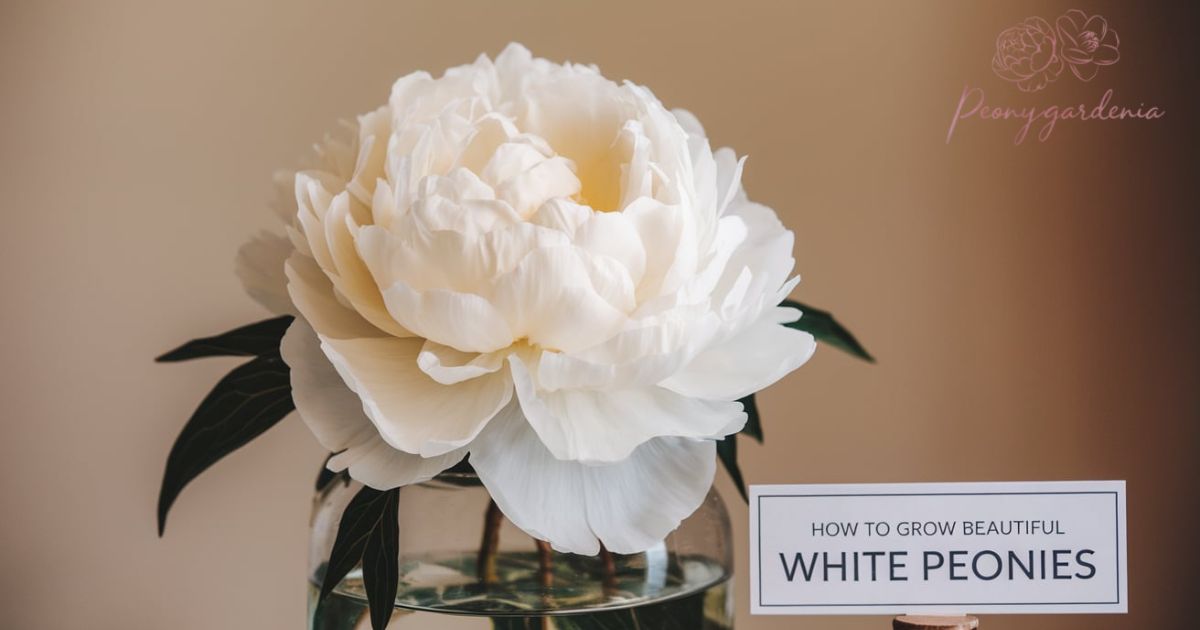White peonies are a stunning addition to any garden, known for their large, fragrant blooms and elegant appearance. With proper care and attention, these perennial flowers can thrive for many years, offering beauty and charm each spring and summer. Growing them is a rewarding experience for gardeners of all levels.
To grow beautiful white peonies, it’s essential to understand their needs, from choosing the right location to ensuring proper planting and maintenance. With the right conditions, these flowers will flourish, providing a breathtaking display of white petals that enhance any landscape or floral arrangement.
Popular White Peony Varieties
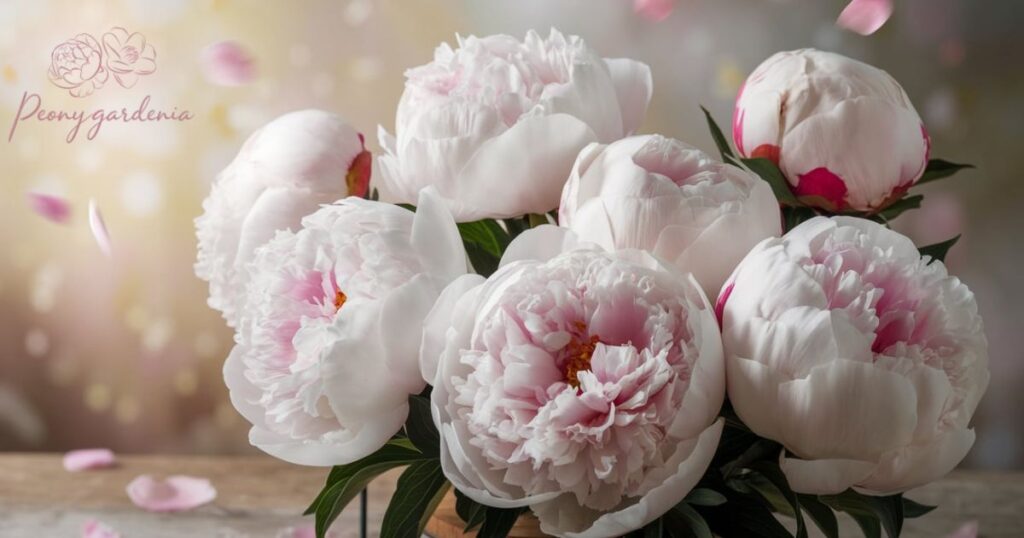
Popular white peony varieties include Festiva Maxima, known for its large blooms and red-tipped centers, and Bride’s Dream, prized for its soft white petals with a hint of blush. Other favorites like White Wings, Gardenia, and Shirley Temple offer unique features, from compact growth to fragrant, creamy blooms, enhancing any garden.
Festiva Maxima Peony
The Festiva Maxima peony is one of the most iconic white peony varieties, known for its pure white petals and striking red-tipped centers. This variety is often chosen for its classic beauty and large, fragrant blooms. The flowers can grow up to 8 inches in diameter, making them a stunning focal point in any garden. As a herbaceous peony, the Festiva Maxima is easy to grow and can tolerate a range of soil types, though it prefers well-drained soil.
This variety is also praised for its strong stems, which help support its large flowers without drooping. Festiva Maxima peonies bloom in late spring to early summer and thrive in full sun or partial shade. Their longevity and disease resistance make them a favorite among gardeners seeking a reliable and low-maintenance plant for their landscape.
Bride’s Dream Peony
Bride’s Dream peony is another popular white variety, known for its elegant, soft white blooms with a hint of blush. These peonies are prized for their romantic appearance, making them a popular choice for weddings and floral arrangements. When in full bloom, they can reach a size of 5 to 6 inches, and the plant typically grows 24 to 36 inches tall.
This peony variety is also known for its fragrance, which adds to its appeal as a cut flower. Bride’s Dream peonies thrive in full sun to partial shade and well-drained soil, and they require minimal care once established.
White Wings Plant
White Wings peony stands out for its delicate white petals that have a light pink blush at the base. The flowers are large and fully double, often measuring 6 to 8 inches in diameter. This variety blooms in late spring and early summer, making it a striking addition to garden beds during the growing season.
The plant grows to about 30 inches in height and prefers well-drained soil and a sunny location. White Wings peonies are also relatively resistant to pests and diseases, making them an easy-to-care-for choice for gardeners. Their long-lasting flowers can also be cut and used in floral arrangements, adding a touch of elegance to any indoor setting.
Read More: How to Freeze Peonies
Gardenia
Gardenia peonies are known for their creamy white, double blooms that resemble gardenia flowers, hence their name. The large, fragrant blooms stand out in the garden, often measuring 6 to 8 inches in diameter. Gardenia peonies are also known for their strong, sturdy stems, which help support the weight of the blooms.
These plants grow to about 30 to 36 inches tall and thrive in full sun. Gardenia peonies prefer slightly acidic, well-drained soil and are relatively resistant to pests. They are also known for their excellent vase life, making them a popular choice for floral arrangements and bouquets.
Honey Gold Plant
Honey Gold peony is known for its soft, creamy white flowers that gradually turn to a pale yellow-gold hue as they mature. The blooms are large and semi-double, often measuring 6 inches across. Honey Gold peonies are a unique variety, offering a subtle color shift that adds an element of interest to the garden.
These peonies grow to about 36 inches tall and thrive in full sun or partial shade. Honey Gold peonies prefer well-drained, fertile soil and can tolerate a range of weather conditions. Their striking color change and large flowers make them a favorite among gardeners looking for something a bit different in their peony collection.
Duchess of Portland Plant
The Duchess of Portland peony is a gorgeous white variety with slightly ruffled petals that form a full, rounded bloom. The flowers can reach up to 7 inches in diameter and have a soft, delicate fragrance. This variety is perfect for adding texture and depth to a flower garden, with its lush blooms that stand out against green foliage.
Duchess of Portland peonies prefer well-drained, fertile soil and full sun. Like many peony varieties, they are relatively low-maintenance and resistant to pests and diseases. Their hardiness and striking appearance make them a great choice for gardeners looking for a reliable, elegant plant.
Shirley Temple Plant
Shirley Temple peony is a popular white variety that features soft, pastel blooms with a hint of pink at the base. The flowers are large and semi-double, creating a full, lush appearance when in bloom. Shirley Temple peonies are known for their sweet fragrance and long-lasting flowers, which makes them perfect for cut flower arrangements.
These peonies grow to about 30 inches tall and thrive in full sun or partial shade. Shirley Temple peonies prefer well-drained, fertile soil and are easy to care for once established. Their graceful appearance and lovely fragrance make them a favorite among gardeners.
When and Where to Plant White Peonies
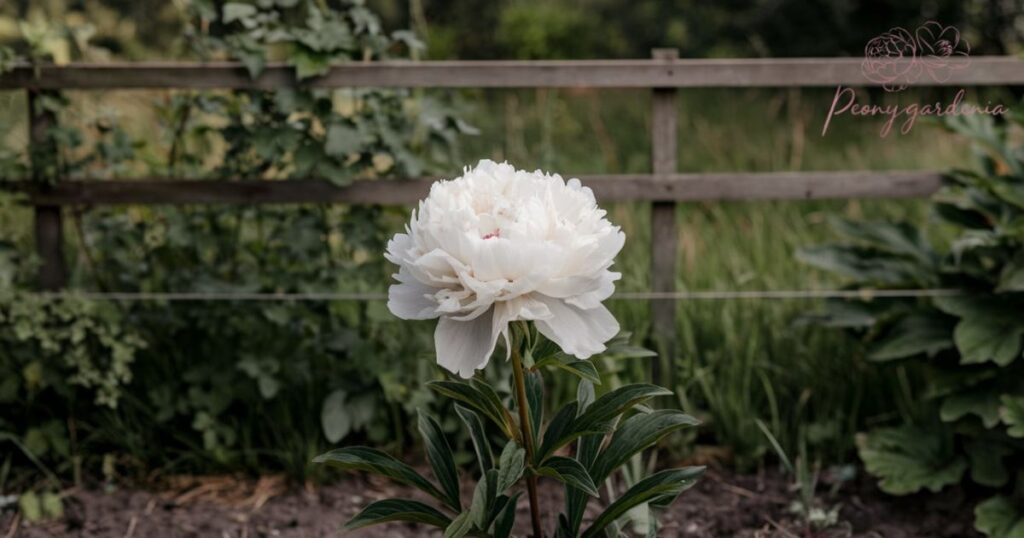
White peonies should be planted in the fall, ideally between late September and early November, allowing roots to establish before winter. They thrive in full sun, requiring at least six hours of direct sunlight daily. Choose a well-drained, fertile spot with good air circulation to prevent disease and ensure healthy growth.
Best Time to Plant White Peonies
The best time to plant white peonies is in the fall, typically between late September and early November. Planting in the fall allows the roots to establish themselves before the cold weather sets in, leading to stronger plants in the spring. Fall planting also provides the flowers with a head start for the growing season, as they will begin blooming in late spring or early summer.
If you miss the fall planting window, early spring is the next best time to plant white peonies. However, spring-planted peonies may take a little longer to establish and bloom compared to those planted in the fall. When planting in spring, wait until the ground has thawed and temperatures remain consistently mild.
Choosing the Right Location
Choosing the right location for white peonies is crucial for their health and success. These flowers thrive in full sun, which helps them produce the best blooms and vibrant foliage. A location that receives at least 6 hours of direct sunlight per day is ideal.
White peonies also prefer well-drained soil that is rich in organic matter. Avoid areas where water tends to pool, as stagnant moisture can lead to root rot. Planting peonies in an area with good air circulation will help prevent diseases such as powdery mildew and botrytis blight, which can affect the plants if they are crowded or shaded.
How to Plant White Peonies
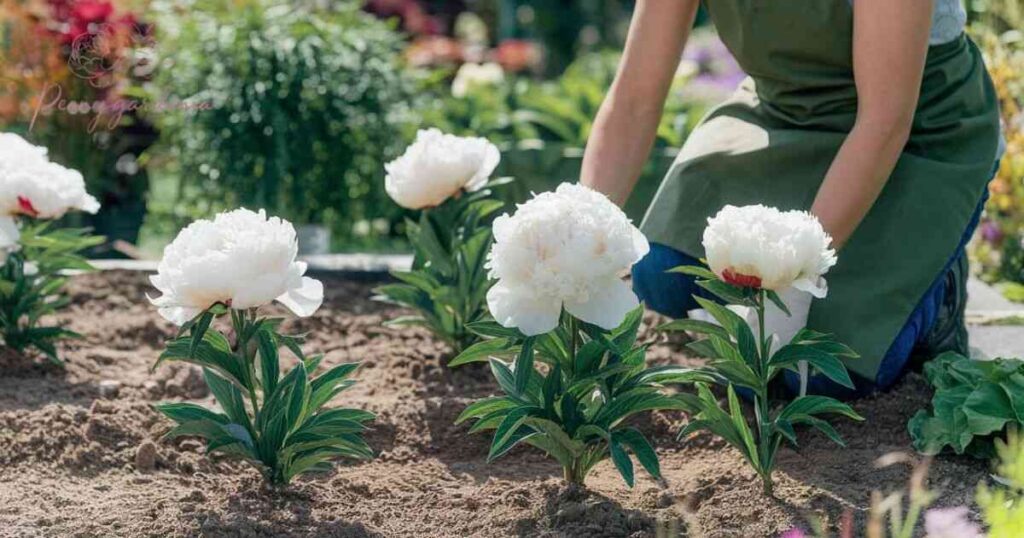
To plant white peonies, you’ll need a few essential materials: peony roots or tubers, a shovel, compost or well-rotted manure, a trowel, and mulch. Peony roots can be purchased from garden centers or online, and they should be plump and healthy. Compost or manure will help enrich the soil, providing the plant with the nutrients it needs to grow strong.
A trowel will assist with digging holes for planting, and mulch helps retain moisture and keep the soil temperature stable. It’s also important to have a good spot for planting, as mentioned previously, ensuring it is sunny and well-drained. Having a level area is key to avoiding waterlogging, which can harm the plant’s roots.
Step-by-Step Planting Guide
- Prepare the Soil: Start by preparing the planting site. Loosen the soil to a depth of 12 to 18 inches, and mix in compost or well-rotted manure. This will improve drainage and provide essential nutrients.
- Dig a Hole: Dig a hole that is about 2 feet wide and 1 to 2 feet deep. Peonies have long, thick roots, so the hole needs to be spacious enough to accommodate them without crowding.
- Plant the Peony Root: Place the peony root in the hole, making sure the “eyes” (small buds) are facing upward. These eyes should be planted no deeper than 2 inches below the soil surface. If the eyes are buried too deeply, the plant may fail to bloom.
- Cover with Soil: Fill the hole with soil and gently pat it down to remove air pockets. Water the plant well after planting.
- Mulch: Add a layer of mulch around the base of the plant to retain moisture and keep the roots cool during hot weather. Avoid piling mulch directly on top of the peony crown.
Caring for White Peonies
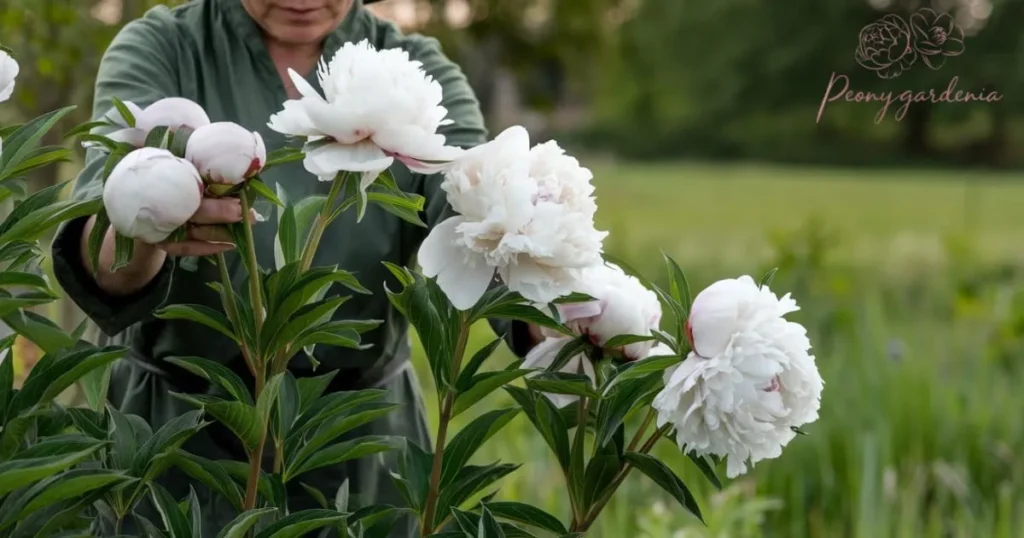
Caring for white peonies involves providing adequate sunlight, water, and well-drained soil. Water them deeply, especially during dry spells, but avoid overwatering to prevent root rot. Fertilize in early spring with a balanced fertilizer, and mulch around the base to maintain moisture and regulate temperature for healthy growth.
Watering
White peonies require regular watering, especially during their growing season. Water the plants deeply, ensuring that the soil is moistened to a depth of at least 6 inches. However, be careful not to overwater, as peonies do not like wet feet and are susceptible to root rot in overly saturated soil. During dry periods, watering once a week should be sufficient, but reduce watering during the winter months when the plant is dormant.
In addition to deep watering, ensure that the soil is well-drained to prevent water from accumulating around the roots. Using a soaker hose or drip irrigation system can help deliver moisture directly to the root zone without wetting the foliage.
Fertilizing
Peonies are relatively low-maintenance when it comes to fertilization, but they can benefit from occasional feeding. Use a balanced, slow-release fertilizer in early spring, just as the plant begins to emerge from dormancy. Apply a light layer of fertilizer around the base of the plant, avoiding direct contact with the roots.
Once the plant has bloomed, there is no need for further fertilization until the following spring. Peonies prefer slightly acidic to neutral soil, so it’s a good idea to test the soil pH periodically and amend it if necessary.
Conclusion
In conclusion, growing beautiful white peonies requires a bit of planning and care, but the effort is well worth it. By selecting the right variety, planting them in well-drained soil with plenty of sunlight, and following proper watering and fertilization practices, you can enjoy stunning blooms year after year.
Regular pruning, deadheading, and proper care will help keep your peonies healthy and thriving. With their timeless elegance, white peonies not only enhance the beauty of your garden but also attract pollinators, making them a valuable addition to any landscape. Their graceful flowers are sure to be a highlight of your garden.
FAQs
When is the best time to plant white peonies?
The best time to plant white peonies is in the fall, ideally between late September and early November.
How much sunlight do white peonies need?
White peonies require at least 6 hours of direct sunlight daily for optimal growth and blooming.
Do white peonies need special soil?
Yes, they prefer well-drained, fertile soil that is slightly acidic to neutral.
How often should I water white peonies?
Water white peonies deeply once a week, especially during dry periods, but avoid overwatering.
Do white peonies attract pests?
While they are relatively pest-resistant, white peonies can occasionally attract aphids or ants.
